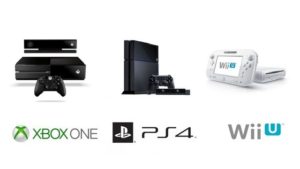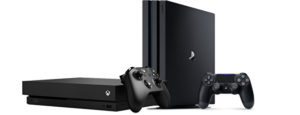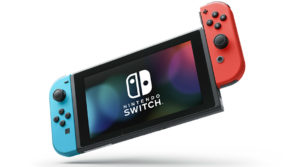2012-present: The Late High-Definition Era



The eighth generation of gaming was introduced in 2012 with the Nintendo Wii U, but it is the PlayStation 4 that would be king. The eighth generation of gaming can be characterized as the first generation to specialize in the mid-generation console upgrade. While previous generations have seen this phenomenon before in the form of cosmetic or more compact upgrades, this will be the first generation to witness a console war predicated on the idea of mid-generation hardware upgrades. Sony and Microsoft went back and forth, introducing more and more powerful hardware to win the hearts of consumers; many of whom are upgrading from high-definition television displays to ultra-high-definition, also known as 4K. High-definition gaming would be standard for all developers, while Microsoft and Sony competed to upgrade to consoles with 4K capabilities.
Although the Wii U ushers in this generation, its disappointing sales resulted in Nintendo abandoning the hardware within five years. The Nintendo 3DS continues to dominate handheld sales, softening the blow of the disappointing Wii U. In 2017, Nintendo introduces the first truly hybrid console, the Nintendo Switch. At best, this innovation has the potential to influence the future of the industry; an industry suffering from the competition of mobile gaming. At the very least, the Nintendo Switch has helped return Nintendo’s legitimacy in developing home consoles. As history continues to write itself, the Nintendo Switch may be recognized as the beginning of the ninth generation of gaming consoles.
Home consoles:
- 2012, November 18: Wii U
Company: Nintendo
Original price: $299.99
2019 price: $327.99
Sales: 13.56 million
Number of Games: 759 (1242 backward compatible Wii games)
Best-selling game: Mario Kart 8 (8.42 million)
Media: Wii U Optical Disc (25 gigs, similar to single layer BD), Wii Optical Disk (4.7 or 8.4 gigs, similar to DVD and DVD-DL), digital downloads
Main controller(s): Wii U GamePad, Wii Remote Plus & Wii U Nunchuk, Wii U Pro Controller
Other peripherals: Wii U Microphone, various amiibos, various headsets, rhythm game controllers (musical instruments)
The Nintendo Wii U was released in 2012 and was the successor to the wildly successful Wii console. It introduced a new gamepad controller with a built-in touchscreen, allowing for new gameplay experiences and the ability to play games without the need for a TV screen. The Wii U also boasted HD graphics and online capabilities, with Nintendo’s Miiverse social network. The Wii U would inspire a legion of loyal Nintendo fans, but it may be seen as Nintendo’s biggest disappointment. So much so that Nintendo ceased its production in 2017 to focus on the Nintendo Switch. An innovative concept with poor execution., the Wii U had hybrid console aspirations, but its hybrid nature was very limited. The Wii U has an awkwardly bulky controller that allows gamers to play games in other rooms or other locations with a Wi-Fi connection. Mobile gaming without Wi-Fi connections was not possible.
Nintendo produced a few classic games for the Wii U, but the console was doomed by a lack of third-party support. Having inferior hardware to the PS4 and Xbox One, most third-party games could not run or look the way they were supposed to on the Wii U. Being the HD generation, graphics meant everything for many gamers.
Backward compatibility is a mixed bag for the Wii U. Nintendo offered diverse yet limited offerings. From Nintendo’s Virtual Console, players could purchase games from any of its previous systems. However, the selection was cherry-picked, and not every title was available. Also, some of these games were relatively expensive when considering the fact that ownership of these games did not transfer from one system to another. If a player wanted to play Super Mario Bros on 3DS and on the Wii U, the game would have to be purchased twice.
Despite the Wii U’s innovative features, it struggled to find its footing in the market. It faced stiff competition from the more powerful PlayStation 4 and Xbox One consoles, and many criticized its confusing branding and lack of third-party support. Nevertheless, it still managed to release some fantastic games, including Super Mario 3D World, Mario Kart 8, and The Legend of Zelda: Breath of the Wild.
- 2013, November 15: PlayStation 4
Company: Sony
Original price: $399.99
2019 price: $431.98
Sales: 96.5 million
Number of Games: 2,042 (PS3 backward compatibility through PlayStation Now)
Best-selling game: Uncharted 4: A Thief’s End (15 million)
Media: Blu-ray (including UHD), DVD, CD, digital downloads
Main controller(s): DualShock 4
Other peripherals: Sony PlayStation VR, Sony PlayStation Camera for PlayStation 4, Sony PlayStation Move Motion Wireless Controller, PDP Bluetooth Remote, rhythm game controllers (musical instruments), various headsets
For the third time in the past four generations of home consoles, Sony ruled the gaming world. The PlayStation 4 came out one week before the Xbox One, was priced at $100 less than its rival, had slightly better graphic capabilities, and had none of the proposed restrictions on games that Microsoft threatened but removed before it released the Xbox One. Four years later Sony would produce an upgrade, the PlayStation 4 Pro. Although it is less powerful than the Xbox One X and could only produce upscale checkerboard rendered 4K graphics, it came out a full year before Xbox’s console upgrade.
The PS4 plays 4K Blu-ray disks that hold up to 50 gigs of data, games can extend past this capacity with downloadable updates. Both systems stream media and play Blu-ray disks, but the PS4 Pro streams video on 4K. Sony opted not to go with a 4k Blu-ray drive in the PS4 Pro because it would allow Sony to set a lower price point for the lack of hardware.
The PS4 is not backward compatible with any PlayStation games in any of the previous generations. However, the PlayStation store sells PS2 games with upgraded graphics. Also, a subscription to so PS Now gives players access to a library of games from both the PS3 and PS4 by steaming these games to their consoles.
- 2013, November 22: Xbox One
Company: Microsoft
Original price: $499.99
2019 price: $539.98
Sales: 40 million
Number of Games: 2,017 (selective backward compatibility with original Xbox and Xbox 360 games)
Best-selling game: PlayerUnknown’s Battlegrounds (8 million)
Media: Blu-ray (including UHD), DVD, CD, digital downloads
Main controller(s): Xbox One Controller, Kinect sensor, Xbox Elite 1 & 2 controllers
Other peripherals: N/A Razer Turret for Xbox One, Xbox Adaptive Controller, Hyperkin Duke for Xbox One, Razer Wolverine Ultimate, Razer Atrox Arcade Stick for Xbox One, PDP Talon Media Remote, rhythm game controllers (musical instruments), various headsets, various racing wheels, various joysticks
The Xbox One is a tale of two cities if each of those cities represents Microsoft’s PR for this system. Before the system launched Microsoft proposed a host of consumer-unfriendly restrictions for the Xbox One. The system would have to be online at all times, and the purchase of physical games would be locked to the original owner, blocking the resale of games. Internet backlash forced Microsoft to back off of these restrictions, but it was too late, the PR damage was done. Many consumers like myself would turn to the PS4, which boasted slightly better graphics and a price tag of $100 less than the Xbox One, reminiscent of PS1’s undercut of Sega Saturn.
Some cool early features lost support in place of alternative features that appealed to more gamers. The early Xbox One consoles were sold with the Kinect, a motion control sensor bar. The Kinect made the console cost an extra $100 than the PlayStation 4, and it made developers focus vital gaming power on the Kinect when the Xbox One was already less powerful than the PS4. After a while, Microsoft mostly abandoned the feature with the elevation of Phil Spencer, who shifted Xbox’s focus back on games. The system was upgraded two times with the Xbox One S and X models, both capable of streaming 4K video and playing 4K Bluray, the latter capable of rendering true native 4K graphics; surpassing the capabilities of the PS4 Pro. Also, the Xbox One became backward with games from both of its previous generation consoles, the original Xbox and the Xbox 360. While not 100 percent backward compatible, Microsoft continues to upgrade its library of backward compatibility.
These changes have been received very positively by gamers, helping Microsoft regain some of the PR lost early in this generation. Despite early setbacks, the Xbox One was able to carve out a solid spot in the console market, thanks to its loyal fanbase and a strong lineup of games.
Second-tier consoles:
- 2015, May 28: Nvidia Shield TV
Company: Nvidia
Original price: $199.99, $299.99 (pro version)
2019 price: $211.69, $317.53 (pro version)
Sales: N/A
Number of Games: More than 225 via GeForce Now, countless others via casting PC games and emulation
Best-selling game: N/A
Media: Digital downloads, digital streaming, USB, Micro SD card (with original model)
Main controller(s): Nvidia Shield Controller (version 1 and 2), generic Bluetooth controllers
Other peripherals: Compatible with most Bluetooth controllers
Nvidia: Nvidia is primarily known for producing graphics processing units (GPUs) for personal computers. However, the company made its initial entry into the video game market with the release of the Nvidia Shield, an Android-based portable gaming console that was launched in 2013. The device was aimed at gamers who wanted to play Android games on the go but also had the added benefit of streaming games from a user’s computer via Nvidia’s GameStream technology. While the Nvidia Shield had a niche following, it didn’t quite gain the mass appeal that some had hoped for. Nevertheless, Nvidia continued to focus on developing technology for the video game industry, with the release of its popular GeForce graphics cards and the development of the powerful Tegra chipsets for use in portable devices.
An excellent gaming console that often doubles as an excellent media peripheral. The Nvidia Shield was built on the premise of streaming PC games in 4K from a gaming PC to an HDTV, and a subscription service to GeForce Now, in which gamers can stream a selection of modern games. The system runs an Android system, giving it a lot of versatility. It plays games from the Android market and it can run accurate emulators of gaming systems up until the PS1. It also serves as a powerful multimedia tool, giving users the ability to stream all major forms of streaming media in upwards of 4K resolution.
Nvidia has long been the dominant force in graphics cards. Nvidia never pushed to make this console compete with the big boys because its versatility gives it the ability to do so. It is limited, but current Internet speeds, which have greatly improved but are not at the point at which streaming games can compete with natively run games. The technology to power this console would be used to power the Nintendo Switch.
Mini consoles:
- 2016, November 11: NES Classic
Company: Nintendo
Original price: $59.99
2023 price: $64.48
Sales: 2.3 million
Number of Games: 30
Best-selling game: N/A
Media: Flash Memory for pre-installed roms
The NES Classic was a miniature replica of the Nintendo Entertainment System released in November 2016. It came preloaded with 30 classic NES games, including favorites like Super Mario Bros., The Legend of Zelda, and Donkey Kong. The console featured an HDMI output, allowing players to connect it to modern televisions and play retro games in high definition. The NES Classic came with one classic NES controller, and additional controllers could be purchased separately. The console was a huge hit with gamers and nostalgic fans alike, with many retailers selling out of stock quickly after release. Despite the demand, Nintendo discontinued the NES Classic in April 2017, leaving many fans disappointed and eager for a restock.
- 2017, September 29: SNES Classic
Company: Nintendo
Original price: Original price: $79.99
2023 price: $82.20
Sales: 5 million
Numnber of Games: 21
Best-selling game: N/A
Media: Flash Memory for pre-installed rooms
The SNES Classic is a mini version of the original console, complete with 21 pre-installed games. The console connects to your TV via HDMI and comes with two controllers, allowing you to play games with a friend. The SNES Classic also features a rewind function, allowing you to go back a few seconds in a game if you make a mistake or want to try something again. And if you want to experience the full nostalgia of the SNES era, you can even play the games with scanlines, giving the illusion of playing on an old CRT TV.
The SNES Classic has been a hit with fans, and it’s easy to see why. The games included are some of the best of the era, and the console itself is a great piece of nostalgia. It’s perfect for those who grew up with the SNES, as well as those who missed out on it the first time around. And at a retail price of $79.99, it’s an affordable way to relive some of the greatest moments in video game history.
Portable consoles:
- 2011, February 26 (JP): Nintendo 3DS
- 2011, March 27 (NA): Nintendo 3DS
Company: Nintendo
Original price: $249.99
2019 price: $281.59
Sales: 75.08 million
Number of Games: 1,300 (Virtual Console – selective backward compatibility with Game Boy, Game Boy Color, Game Boy Advance, Nintendo Entertainment System, Super Nintendo Entertainment System, Game Gear, Sega Master System)
Best-selling game: Mario Kart 7 (18.26 million)
Media: ROM cartridge, digital downloads
The Nintendo 3DS was Nintendo’s successor to the incredibly popular Nintendo DS. It featured a similar dual-screen design as its predecessor but included an extra dimension, stereoscopic 3D. The 3DS utilized a parallax barrier LCD screen technology to display 3D visuals without the need for glasses. It was also backward compatible with DS games, allowing gamers to continue enjoying their existing library of games.
The 3DS boasted a wide variety of games, from first-party Nintendo classics like Super Mario and The Legend of Zelda to third-party games like Monster Hunter and Resident Evil. One of its unique features was its augmented reality capabilities, allowing players to interact with the real world using the 3DS’s camera and AR cards. It also had online connectivity, allowing players to download new games, participate in multiplayer matches, and share game data with friends. Overall, the Nintendo 3DS proved to be another hit for Nintendo, with over 75 million units sold worldwide.
- 2011, December 17 (JP): PlayStation Vita
- 2012, February 22 (N/A): PlayStation Vita
Company: Sony
Original price: $249, $299 (3G model)
2019 price: $275.30, $330.58 (3G model)
Sales: 4 million
Number of Games: 1,562 (selective backward compatibility with PSP, PS1, PS2, Neo Geo AES, PC Engine)
Best-selling game: Uncharted: Golden Abyss (1.62 million)
Media: ROM cartridge, digital downloads
The PlayStation Vita was Sony’s second attempt at breaking into the handheld gaming market, following the PlayStation Portable (PSP). The Vita boasted impressive hardware specs, including a vibrant OLED screen, dual analog sticks, and touch controls on both the front and back of the device. The Vita was also capable of playing high-quality games previously only available on consoles, such as Uncharted: Golden Abyss and Persona 4 Golden.
This system had a lot of promise but fell to the wayside a bit too early for PS Vita owners. It was backward compatible with the PSP and the PS1, allowing users to re-download previously purchased titles. The PS4 was designed to stream its games over an Internet connection to the PS Vita. Many PS Vita games were cross-save compatible with the PS4, allowing users to continue a PS4 game on the go, and vice versa.
The bane of this system was threefold. Firstly, Sony insisted on using a very expensive proprietary memory system for this console, increasing the expense of owning this system. Secondly, the increased popularity of mobile gaming, made the purchase of gaming unnecessary. Thirdly, the previously stated factors and the unbeatable portable gaming opponent of Nintendo hurt the sales of this console, and in turn, have led to Sony abandoning the support of this console at an earlier stage of its life. Essentially, Sony pulled the plug on this console, instead of doubling down on its bet on a losing horse.
Despite its impressive hardware and game library, the Vita struggled to find a foothold in the market. Additionally, the rise of mobile gaming on smartphones made it difficult for dedicated handheld consoles to compete. Sony eventually discontinued production of the Vita in 2019, marking the end of its brief tenure in the handheld gaming market.
- 2013, July 31: Nvidia Shield Portable
Company: Nvidia
Original price: $299.99
2019 price: $323.26
Sales: N/A
Number of Games: More than 225 via GeForce Now, countless others via casting PC games and emulation
Best-selling game: N/A
Media: Digital downloads, digital streaming, Micro SD card
Never a major contender, the Nvidia Shield Portable has most of the same capabilities as the Nvidia Shield TV. It streams games from a PC and from GeForce Now, but a network connection is required. For non-network portable gaming, this system can run emulators and games from the Android market. The Android market is ironically one of this system’s downfalls, the popularity of mobile gaming has made video game consoles and other hardware unnecessary from the view of many gamers. Being popular with a niche group of gamers, it was not a huge success and was discontinued in 2015.